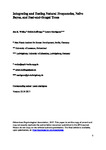Integrating and testing natural frequencies, naïve Bayes, and fast-and-frugal trees.
| dc.contributor.author | Woike, Jan Kristian | |
| dc.contributor.author | Hoffrage, U | |
| dc.contributor.author | Martignon, L | |
| dc.date.accessioned | 2020-10-21T14:52:15Z | |
| dc.date.available | 2020-10-21T14:52:15Z | |
| dc.date.issued | 2017-10-01 | |
| dc.identifier.issn | 2325-9965 | |
| dc.identifier.issn | 2325-9973 | |
| dc.identifier.uri | http://hdl.handle.net/10026.1/16574 | |
| dc.description.abstract |
This article relates natural frequency representations of cue-criterion relationships to fast-and-frugal heuristics for inferences based on multiple cues. In the conceptual part of this work, three approaches to classification are compared to one another: The first uses a natural Bayesian classification scheme, based on profile memorization and natural frequencies. The second is based on naïve Bayes, a heuristic that assumes conditional independence between cues (given the criterion). The third approach is to construct fast-and-frugal classification trees, which can be conceived as pruned versions of diagnostic natural frequency trees. Fast-and-frugal trees can be described as lexicographic classifiers but can also be related to another fundamental class of models, namely linear models. Linear classifiers with fixed thresholds and noncompensatory weights coincide with fast-and-frugal trees-not as processes but in their output. Various heuristic principles for tree construction are proposed. In the second, empirical part of this article, the classification performance of the three approaches when making inferences under uncertainty (i.e., out of sample) is evaluated in 11 medical data sets in terms of Receiver Operating Characteristics (ROC) diagrams and predictive accuracy. Results show that the two heuristic approaches, naïve Bayes and fast-and-frugal trees, generally outperform the model that is normative when fitting known data, namely classification based on natural frequencies (or, equivalently, profile memorization). The success of fast-and-frugal trees is grounded in their ecological rationality: Their construction principles can exploit the structure of information in the data sets. Finally, implications, applications, limitations, and possible extensions of this work are discussed. | |
| dc.format.extent | 234-260 | |
| dc.language | en | |
| dc.language.iso | en | |
| dc.publisher | American Psychological Association (APA) | |
| dc.title | Integrating and testing natural frequencies, naïve Bayes, and fast-and-frugal trees. | |
| dc.type | journal-article | |
| dc.type | Journal Article | |
| plymouth.issue | 4 | |
| plymouth.volume | 4 | |
| plymouth.publication-status | Published online | |
| plymouth.journal | Decision | |
| dc.identifier.doi | 10.1037/dec0000086 | |
| plymouth.organisational-group | /Plymouth | |
| plymouth.organisational-group | /Plymouth/Faculty of Health | |
| plymouth.organisational-group | /Plymouth/Faculty of Health/School of Psychology | |
| plymouth.organisational-group | /Plymouth/REF 2021 Researchers by UoA | |
| plymouth.organisational-group | /Plymouth/REF 2021 Researchers by UoA/UoA04 Psychology, Psychiatry and Neuroscience | |
| plymouth.organisational-group | /Plymouth/REF 2021 Researchers by UoA/UoA04 Psychology, Psychiatry and Neuroscience/UoA04 Psychology, Psychiatry and Neuroscience MANUAL | |
| plymouth.organisational-group | /Plymouth/Users by role | |
| plymouth.organisational-group | /Plymouth/Users by role/Academics | |
| dc.identifier.eissn | 2325-9973 | |
| dc.rights.embargoperiod | Not known | |
| rioxxterms.versionofrecord | 10.1037/dec0000086 | |
| rioxxterms.licenseref.uri | http://www.rioxx.net/licenses/all-rights-reserved | |
| rioxxterms.type | Journal Article/Review | |
| plymouth.funder | Simple Heuristics for Human Inferences::Swiss National Science Foundation |


